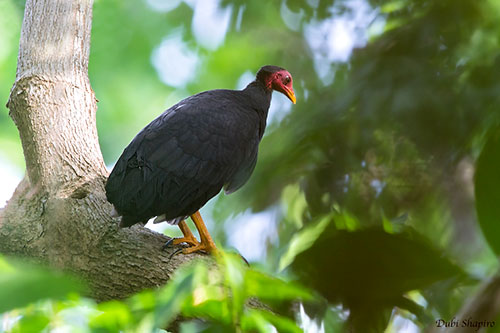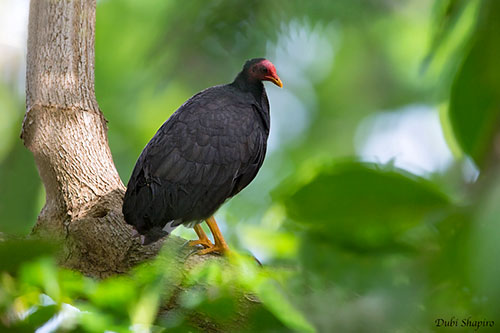
Fr: Mégapode de Layard
Ang: Vanuatu Scrubfowl or Vanuatu Megapode
All: Layard-Großfußhuhn
Esp: Talégalo de Nuevas Hébridas
Ita: Megapodio delle Vanuatu
Nd: Vanuatuboshoen
Sd: vanuatustorfotshöna
Photographer:
Dubi Shapiro
Dubi Shapiro Photo Galleries & Dubi Shapiro's Pictures on IBC
Text by Nicole Bouglouan
Sources:
HANDBOOK OF THE BIRDS OF THE WORLD Vol 2 by Josep del Hoyo-Andrew Elliot-Jordi Sargatal - Lynx Edicions - ISBN: 8487334156
Birds of Melanesia: Bismarcks, Solomons, Vanuatu and New Caledonia Par Guy Dutson – Editeur : Bloomsbury Publishing, 2011 – ISBN: 1408152460, 9781408152461
L’ENCYCLOPEDIE MONDIALE DES OISEAUX - Dr Christopher M. Perrins - BORDAS - ISBN: 2040185607
The Vanuatu Megapode Megapodius layardi, monitoring and conservation
Megapodes: A Fascinating Incubation Strategy
Vanuatu Scrubfowl or Megapode
Megapodius layardi
Galliformes Order – Megapodiidae Family
INTRODUCTION:
The Vanuatu Scrubfowl is endemic to Vanuatu where it occurs on the larger islands in C and N of the archipelago. It is mainly found in lowland forest, but it usually breeds near the coast where the very peculiar incubation strategy can be used.
The Megapodiidae are known for their strategy involving incubation and hatching of their eggs by laying them underground, in burrows or under mounds of sand or earth. The incubation is carried out by natural sources of heat including microbial, solar sources or volcanically-heated soils.
The Vanuatu Scrubfowl is threatened by egg and chick collecting and degradation of the habitat. The small population is declining and the species is currently listed as Vulnerable.
DESCRIPTION OF THE BIRD:
Biometrics:
Length: 42-45 cm
The Vanuatu Scrubfowl adult has brownish-black plumage overall.
On the head, forehead and face have pinkish-red bare skin. On the hindcrown, some dark feathers may form a short, indistinct crest.
The bill is dull yellow. The eyes are brown. Legs and feet are bright yellow.
Legs and feet are very strong, giving the bird its name “megapodius” which comes from the Greek for “big foot”. The development of legs and feet is closely related to the nesting behaviour of the bird that digs large burrows where the eggs are laid. In the same way, they are also adapted to a largely terrestrial life.

Male and female are similar, but the female has duller legs and feet.
The juvenile is duller than adults. Legs and bill are browner. The plumage becomes blacker as both red facial skin and yellow legs are progressively visible.
RANGE:
The Vanuatu Scrubfowl is found in C and N Vanuatu and on Banks Islands.
HABITAT:
The Vanuatu Scrubfowl usually frequents lowland forest where it is generally seen on the floor. It may occur up to 800 metres of elevation.
This species breeds in coastal areas, on beaches, especially around rotting trees, and also in volcanically-heated areas. Some birds may frequent degraded forest and gardens.
CALLS AND SONGS: SOUNDS BY XENO-CANTO
The Vanuatu Scrubfowl produces harsh croaks or clucking notes. From several observations, the optimal calling activity occurs at dawn between 04.30 and 05.30.
During the breeding season, male and female perform a duet, mainly at night, but also at any time of the day. This duet is often initiated by the female and described as disyllabic “took-tooorrr” lasting 4-5 seconds.
While foraging in pairs, both mates give softer calls to maintain the contact. We can also hear a loud wailing “ko-wah” followed by ascending “wo-wo-wo” quacks.
BEHAVIOUR IN THE WILD:
The diet of the Vanuatu Scrubfowl is poorly known, but it takes insects, worms, grubs, snails and various other invertebrates. Plant matter such as fruit, seeds, buds, flowers and leaves are also part of its diet.
It forages by walking along and scratching in the leaf litter with its strong feet. It also pecks at other food items on ground or at plants. They can be seen in pairs most of the time. They are rather shy and difficult to observe.
Like most Megapodiidae, the Vanuatu Scrubfowl is probably monogamous and territorial. The mound and the burrow are usually built and maintained by the male.
They often breed communally, with several females laying their eggs in the same nest. This behaviour is related to the scarcity of suitable nest-sites. The species appears to breed all year round throughout the range.

The Vanuatu Scrubfowl is sedentary, but it may fly off on offshore islets for roosting. Some movements over water are known to occur, particularly on small islands.
This species usually runs rather than fly if alarmed, but it is able to make a fast take-off to escape predators. The flight is fairly strong and usually steeply upwards, on rounded wings and trailing legs.
REPRODUCTION OF THIS SPECIES:
The Vanuatu Scrubfowl may breed all year round, and especially in June-August.
This species lays the eggs within a burrow dug between decaying roots and around rooting trees, or in volcanically-heated areas and decomposing vegetation.
On Banks Islands, the species is probably mound-builder.
Several females lay in the same nest. The burrow is 30-200 cm deep and up to 200 cm long. Between 20 and 100 eggs may be laid per burrow by several females.
The incubation is fairly long and lasts about 45 days. It is made by natural sources of heat such as some sort of volcanic activity, solar energy (especially on beaches), and by the source of heat created by the decay of rooting tree roots.
Once hatched, the chick struggles up to the surface, and needs from some hours to a full day or more. It is able to completing such a journey because it is super-precocial, a very advanced stage already upon hatching.
The chick is usually large, a direct result of the long incubation period. It is pale buff-brown with dark barring on the upperparts and has paler underparts. It weighs 60 grams at hatching. It is soon like miniature adult and is independent.
PROTECTION / THREATS / STATUS:
The Vanuatu Scrubfowl is threatened by egg and chick collecting for consumption and for sale in local markets. This species is also affected by degradation of the habitat for logging and agriculture expansion, while the forest floor is degraded by cattle-grazing. It is also hunted by humans and killed by feral dogs.
The Vanuatu Scrubfowl has small, declining population roughly estimated to number 3,500/15,000 individuals.
The species is currently listed as Vulnerable.